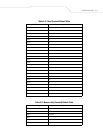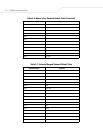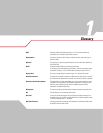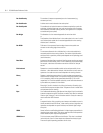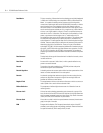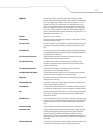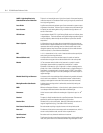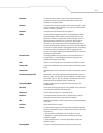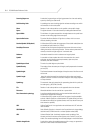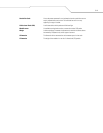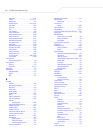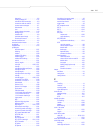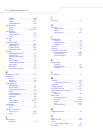
GL-7
Orientation The alignment of the symbol's scan path. Two possible orientations are
horizontal with vertical bars and spaces (picket fence) and vertical with
horizontal bars and spaces (ladder).
Overhead The fixed number of characters required for start, stop and checking in a given
symbol. For example, a symbol requiring a start, stop and 2 check characters
contains 4 characters of overhead.
Parameter A variable that can have different values assigned to it.
PDF417 An error correcting 2-dimensional multi-row symbol developed in 1992 by
Symbol Technologies, PDF417 symbols are constructed from 4 bars and 4
spaces over 17 modules. The symbol size is from 3 to 90 rows. There is no
specified minimum or maximum for X or Y dimension. With at least the
recommended minimum level of error correction, the recommended Y
dimension is 3X. With less than the minimum recommended level of error
correction, the recommended Y dimension is 4X. A quiet zone of 2X is specified
on each side of a symbol. Because of delta decode techniques, the symbology
is immune from uniform bar width growth. PDF417 supports cross-row
scanning. The intellectual property rights associated with PDF417 have been
committed to the public domain.
Percent Decode The average probability that a single scan of a bar code would result in a
successful decode. In a well-designed bar code scanning system, that
probability should approach near 100%.
Pitch Rotation of a bar code symbol in an axis parallel to the direction of the bars.
Plessey Code A pulse-width, modulated bar code commonly used for shelf marking in grocery
stores.
Postnet Code Code developed by the U.S. Postal Service to assist in the automatic sorting of
mail.
Print Contrast Signal (PCS) Measurement of the contrast (brightness difference) between the bars and
spaces of a symbol. A minimum PCS value is needed for a bar code symbol to
be scannable. PCS = (RL - RD) / RL, where RL is the reflectance factor of the
background and RD the reflectance factor of the dark bars.
Programming Mode The state in which a scanner is configured for parameter values. See
SCANNING MODE.
Quiet Zone A clear space, containing no dark marks, which precedes the start character of
a bar code symbol and follows the stop character.
Reflectance Amount of light returned from an illuminated surface.
Resolution The narrowest element dimension which is distinguished by a particular
reading device or printed with a particular device or method.
RSS Reduced Space Symbology: A family of space efficient symbologies developed
by UCC.EAN.
Scan Area Area intended to contain a symbol.
Scanner An electronic device used to scan bar code symbols and produce a digitized
pattern that corresponds to the bars and spaces of the symbol. Its three main
components are:
1. Light source (laser or photoelectric cell) - illuminates a bar code.
2. Photodetector - registers the difference in reflected light (more light
reflected from spaces).
3. Signal conditioning circuit - transforms optical detector output into a
digitized bar pattern.
Scanning Mode The scanner is energized, programmed, and ready to read a bar code.



